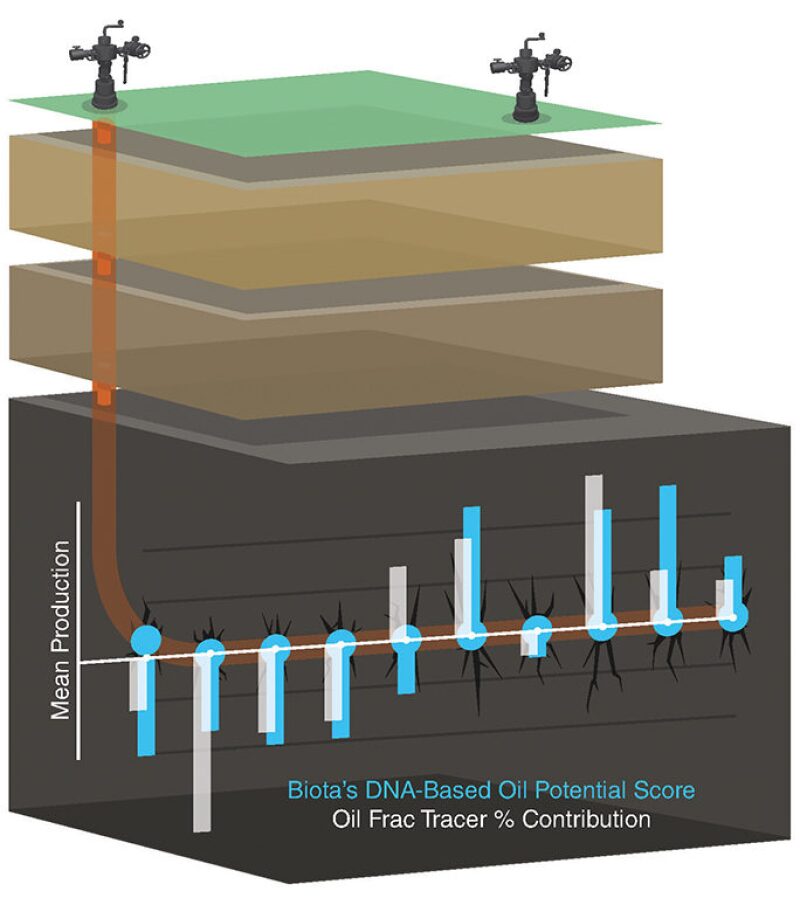For the past 2 decades, the use of DNA sequencing technology has largely been relegated to the domains of criminal forensics and the healthcare industry. The company betting that the shale industry soon will join that list is Biota Technology, a California-based startup.
Founded in 2013, Biota says DNA sequencing technology can help maximize production in horizontal shale wells by directing operators where to place the wells, and how they should be completed.
“We are addressing questions that our customers can’t answer today across multiple scales: Where are the sweet spots and producing intervals for each stage, what is the fracture height for each well, and what is the connectivity between multiple wells?” said Ajay Kshatriya, chief executive officer of Biota.
Biota so far has used its technology on 60 wells operated by six different US producers. Its novel approach involves analyzing the DNA of tiny microbes that coexist with the oil, water, and rock in the subsurface. There are hundreds of thousands of different microbes living inside a formation but certain species are associated with hydrocarbons tend to stand out.
Their unique signatures and locations along the wellbore allow Biota to generate a production profile which can then be used to design engineered completions in subsequent wells, or to identify refracturing opportunities.
“Think of the DNA as a tracking device,” said Kshatriya. “It is a high-resolution data source that provides 4D analysis across the production life cycle, which doesn’t introduce environmental risk or require downhole tools.”
During a drilling operation, as many as 600 samples may be taken from a single well. These samples come from drilling mud and cuttings and provide baseline data needed to characterize the well as production begins and commingles all of the microbial DNA.
More samples are taken during completion operations and then from produced oil and water during production. To screen for contamination, Biota samples several sources of DNA, including the humans working on the job and any dirt at the drillsite that may be swept into the well during operations.
All this information is compiled and sifted through by the company’s data scientists and its machine learning software to find the most important correlations.
Among Biota’s largest investors is a multibillion dollar company called Illumina, a leading DNA technology developer that credits itself as a pioneer in the effort to drive down sequencing costs from around USD 100,000 per sample to about USD 100 in just 5 years.
As it continues to build a track record and demonstrate its value proposition to the industry, Biota has yet to disclose its pricing structure.
But the company notes that it was founded on the idea that the new and dramatically lower price point meant shale producers could now afford to use DNA sequencing as a diagnostic technology in each and every well—an aspect that the company hopes will distinguish it from the established technologies it is competing against.
Production logs are generally viewed as expensive and they require wells to be shut in for a period of time until the tool run is completed. Biota’s sampling process is done at the surface, from a shale shaker or a flowline for instance, and requires no shut-ins or anything to be sent downhole.
“Tracers and microseismic are also great tools,” noted Kshatriya. “But you can’t get that 4D snapshot along the life cycle of the well—you get an initial point in time and that’s their real limitation.”
Biota is also putting its technology next to downhole fiber-optic systems which have gained wide acceptance in the industry for their ability to deliver high-resolution data. Like DNA sequencing, fiber-optic systems provide data for months after installation, if the fiber remains intact, but their biggest downside is cost. At around USD 1 million per installation, fiber-optic systems are generally used only on pilot projects and science wells.
Perhaps the most similar technology to DNA sequencing in terms of data output is geochemistry testing. DNA sequencing and geochemistry tests can be run at any point in time to analyze the makeup of a well’s production stream and depend on the presence of organic materials to generate usable insights.
Biota says its DNA data line up with geochemistry tests, per independent studies. But the company points out that DNA sequencing provides 1,000 times more data than a geochemistry test, which allows it to detect much smaller variations in production behavior.
The company has also explored DNA sequencing applications for conventional wells and offshore production facilities. In the short term, Biota has goals to integrate DNA data with other subsurface data sets that companies routinely use. Farther down the road, it hopes to develop new ways to analyze the DNA data in real time. Current lead time from field to laboratory results is about 2–3 weeks.


